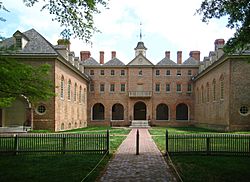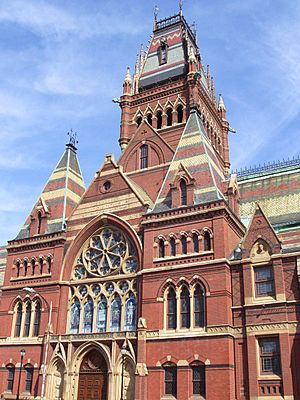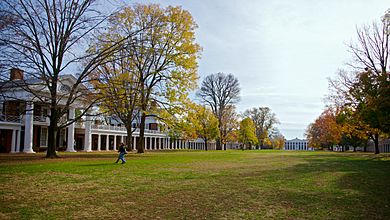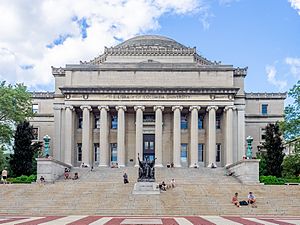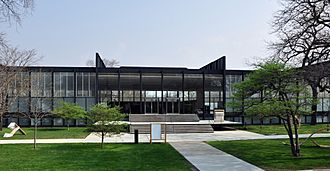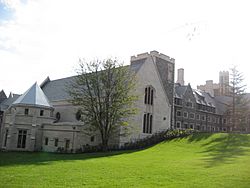History of college campuses and architecture in the United States facts for kids
The history of college campuses in the United States started in 1636. That's when Harvard College was founded in Cambridge, Massachusetts. Back then, it was called New Towne.
Early American colleges, like Harvard, William & Mary, Yale University, and Princeton, were inspired by schools in England and Scotland. But over time, American colleges began to change, both in their buildings and how they taught.
The first American colleges were connected to different Christian religions. For example, Brown University was started by Baptists. Columbia University (then King's College) was founded by the Church of England. These religious ties influenced how the campuses looked and where they were built. There was a focus on religious buildings. Colleges also wanted to be in the countryside to avoid the problems people thought came with big cities.
As more colleges were built, many stopped being so closely tied to religions. Their architecture also became more varied. One famous style that appeared on American campuses is Collegiate Gothic. But there were also many local styles, like the Arts and Crafts campus at Principia College and the Cherokee Gothic buildings at the University of Oklahoma.
Contents
Early American Colleges: What Were They Like?
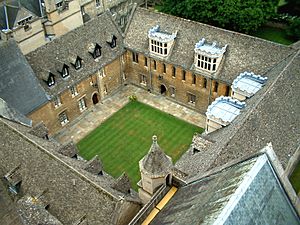
The first American colleges, known as the Colonial colleges, were based on British schools like Oxford and Cambridge. British colleges often looked like old monasteries. They were designed to be separate from the outside world. This design also saved space, as Oxford and Cambridge were already busy cities. It also offered protection during conflicts.
Oxford and Cambridge were divided into smaller colleges, usually built around green areas. American colleges used space differently. Few early American schools were set up like the English ones. American schools also had different teaching methods. Oxford and Cambridge were more open-minded than American colleges, which were founded with strong religious beliefs.
What Does "Campus" Mean?
The word campus was first used for Princeton's main building and the land around it. The word comes from Latin and means "a field." At first, it only referred to the unique green spaces at American colleges. But later, it came to mean the entire college property.
Colonists built colleges very quickly, showing how important education was to early Americans. Harvard was the first. Harvard, William & Mary, and Princeton built huge buildings. Several schools even claimed to have the largest building in the British colonies. Most of the thirteen original colonies had colleges. Many were in rural areas. This was partly to educate Native Americans. Later, it was because Americans thought cities were bad and nature was good.
How Early Campuses Were Organized
While Oxford and Cambridge had slightly different building styles, American colonial colleges varied much more. Harvard started as one building. It later grew to four buildings, forming an open quadrangle. These buildings stood alone, mixing Puritan ideas with Oxford and Cambridge designs. By the end of the colonial period, more buildings formed a row. This was more open than the enclosed quadrangles in England. It was an American idea, needed because of the fear of fire. English buildings used stone, not wood, so fire was less of a worry there.
William & Mary's campus also avoided the enclosed quadrangle. It started as one building that burned down. It was replaced by a single structure, the Wren Building. It was named after its supposed designer, Christopher Wren. The new building had three sides, open on the fourth. This was a style Wren liked. He didn't like four-sided, monastery-like buildings. Later, two small buildings were added: a house for the college president and the "Indian School." This made the campus look like an English country estate.
Like William & Mary, Princeton was built around one main building. Few additions were made during the colonial period. This building, Nassau Hall, was one of the largest and most impressive in colonial America. Many other schools copied its design later, like University Hall at Brown. Yale's early plans were also very influential. Yale completely rejected the quadrangle. Its first buildings were narrow and lined up in a row, forming a wall facing the town of New Haven.
Colleges Grow and Change
After the American Revolution, many more colleges appeared. By the 1820s, there were at least 45. Like the earlier ones, these were connected to Christian religions, though sometimes very small ones. They were also mostly in rural areas. Unlike today, there wasn't much focus on large lecture halls or libraries. Students mostly memorized things and recited them. However, colleges controlled students' lives outside of class. This meant they needed to build many dorms, kitchens, and bathrooms.
New universities copied the layouts of Yale, William & Mary, and Princeton. Others created new designs. The University of North Carolina was the first to use the "mall" model. Buildings faced each other along a central green space. The University of South Carolina later held a design contest. Robert Mills won. He planned a campus like Princeton's, with one main building. But in the end, its campus was also designed around a mall.
New Building Styles
In the early 1800s, many campuses used Greek Revival architecture. This style copied old Classical architecture from Greece. It influenced both individual buildings and overall campus layouts, with a new focus on symmetry. For example, the Whig and Cliosophic Halls at Princeton look like Greek temples. They are symmetrical in design and placement.
Around the 1830s, people also became interested in Gothic architecture. This led to the Gothic Revival style. People mistakenly thought Gothic style came from England. Anglican colleges, like Columbia University, led this shift. Two notable campuses designed in the Gothic style were Kenyon College and the unfinished Jubilee College. Kenyon College's main building, Old Kenyon, was the first college building in the U.S. designed in Gothic style. There were different types of Gothic, like the Ruskinian Gothic, which had different colors and looks.
During this time, buildings also started to be placed further apart. This was a big change from earlier campuses, like Virginia's and Yale's, where buildings were very close together.
Land-Grant Schools and More Access to Education
During the Civil War, the first Morrill Land-Grant Acts was passed in 1862. This law helped create colleges that would teach "the people" practical skills. They also supported farming and industrial research. Before this act, colleges that focused on practical skills had simpler designs. They cared more about usefulness than fancy architecture.
Frederick Law Olmsted was important in shaping these land-grant colleges. He believed campuses should fit into the local community, not be too rural or too urban. His planning idea was practical: slowly add smaller buildings as needed, instead of building one or many large buildings all at once. Olmsted advised about 20 different schools. Many followed his advice, leading to the beautiful, park-like look of many land-grant campuses.
Colleges for Women
Colleges for women started in the 1850s. Their campuses were usually in rural areas. Often, one large building housed all the college's activities. This was meant to protect and control students and create a family-like feeling. But by the 1870s, having all functions in one building became impractical and outdated.
Late 1800s Campus Design
In the late 1800s, Beaux-Arts architecture became very popular. Many new campuses built during this time used this ornate style, which was inspired by classical architecture. A great example is Columbia University. In 1892, Columbia started moving its campus to a new location. The architecture firm McKim, Mead, and White designed many of its new buildings, including the Low Library. This change in style reflected new trends in city planning.
Not all colleges built in the Beaux-Arts style. While many chose elaborate designs, others avoided such expensive campuses. Johns Hopkins University, for example, chose practical designs. The university built buildings that blended with the surrounding city. This choice was due to money limits and the university's focus on graduate studies, like German schools.
20th Century Campuses
World War II and College Growth
The Great Depression slowed down building on many campuses, including Harvard's. Then, World War II caused problems for colleges. However, right after the war, many more students attended college because of the G.I. Bill. This bill paid for returning soldiers' tuition. This led to a huge building boom on campuses across the country.
Modern Styles on Campus
Modernist architecture was new and a bit controversial in the U.S. It was very different from older college styles. Hunter College was one of the first campuses to use Modernist design, and it received praise for it. There was a big debate about whether Modern architecture was better than older styles. Walter Gropius, a leading Modernist, even debated it in New York Times. Gropius later worked for Harvard and designed several buildings there.
Later, Illinois Institute of Technology built its entire campus in the Modernist style. Mies van der Rohe had a lot of freedom to show off Modernist techniques there. A great example is S. R. Crown Hall, built from 1950 to 1958. Other campuses that are mostly Modernist include Florida Southern College, designed by Frank Lloyd Wright, and the campus of the former Black Mountain College.
Today's Campus Architecture
Today, college campuses feature many different building styles. Some new buildings look like older ones. For example, Whitman College at Princeton was designed by Demetri Porphyrios to look like earlier Collegiate Gothic buildings on campus.
This is different from other new buildings, like the Lewis Science Library by Frank Gehry. That building has a Deconstructivist design. Nearby, Butler College was partly designed by postmodern architect Robert Venturi.
Some schools, like Rhodes College and Franklin and Marshall, have stuck to their original building styles. Rhodes College continues to build in the Collegiate Gothic style. Franklin and Marshall uses Georgian and Colonial revival styles. These choices have sometimes caused debate. Princeton and Yale have been criticized for the high cost and difficulty of use of their new residential colleges built in traditional styles.
Other schools, like the Massachusetts Institute of Technology (MIT) and the University of Cincinnati, have embraced experimental and modern architecture. The MIT campus has buildings by Modernists like Eero Saarinen and I.M. Pei, and newer buildings by architects like Steven Holl. Similarly, Cincinnati's campus has works by many Modernists and contemporary architects, including Frank Gehry, Machado and Silvetti, and Michael Graves.
The Future of Campuses
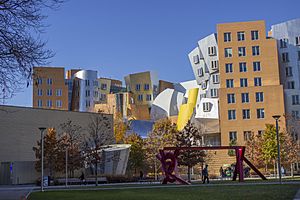
With the rise of online colleges, like the University of Phoenix, and the increasing cost of tuition, some people think colleges will change a lot. There might be fewer students on traditional campuses. The idea of living at a four-year college might also change.


